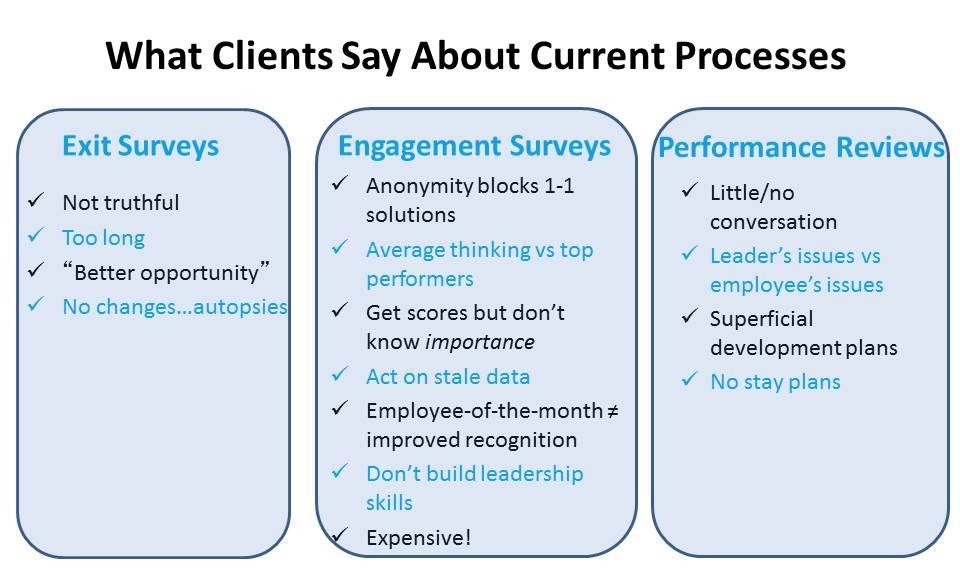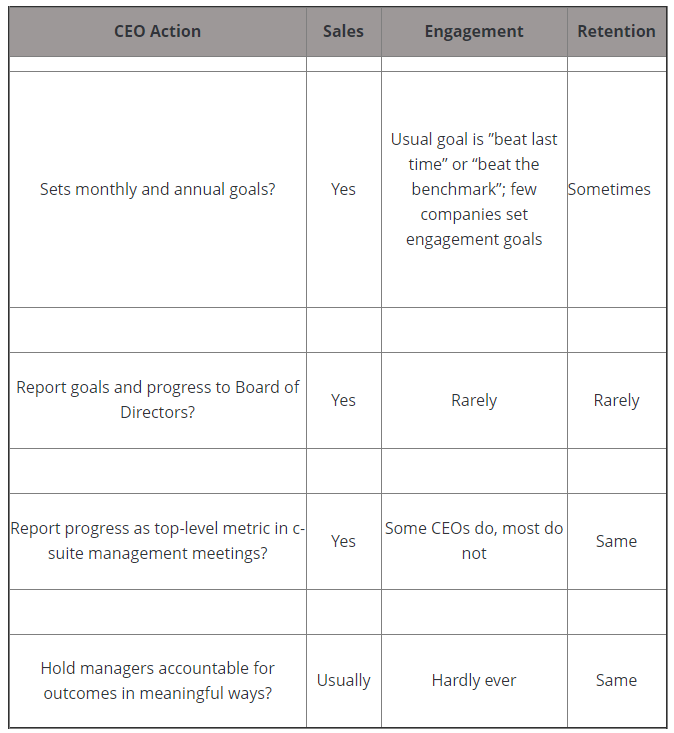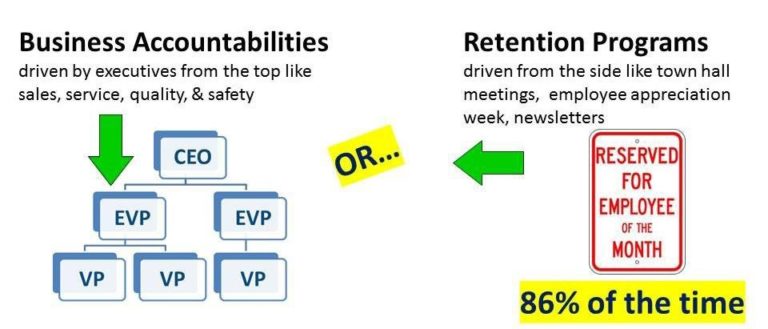At SHRM Talent Conference 2024 I asked the room this question: Who here has ever heard of one manager getting fired for a low employee engagement survey score? Please raise your hand if you can think of even just one. The only sound was the 400-plus attendees turning in their seats to see if anyone raised their hands. There were no hands up.
4 Missing Pieces From Your Employee Engagement Program

Jump To:
Engagement Survey Myths | Missing Piece #1 | Missing Piece #2 | Missing Piece #3 | Missing Piece #4 | The Solution: Stay Interviews
Our clients have shared so many frustrations about their employee engagement surveys that I’ve reached this conclusion: On a scale of 1 to 10 with 10 being high, engagement surveys score an 8 on data and a 3 on solutions. In fact, the image of Human Resources executives describing their survey woes brings to mind a seldom-used word which is gauntlet, defined by Merriam-Webster as “a test of faith, patience, or strength”, a synonym for “ordeal”. And I am sure this resonates with many as one of my most read blogs is “Are Exit Interviews More Like Autopsies or Toe Tags?”
The simply-said reason why is because engagement surveys bring data but they don’t bring solutions.

Here are 7 common myths related to engagement surveys:
- Our survey will tell us what our employees think
(Actually it tells you what an average employee thinks, and mathematically it’s likely not one single employee really thinks this way) - We’re especially interested in engaging and retaining our top performers
(But no survey data reports their information because top performers’ anonymous opinions are mixed in with all others’ opinions) - One reason we pay so much money to our survey company is to compare our results to industry benchmarks
(Except “benchmarks” means “averages” and “average” means “mediocre”, so we end up feeling great about being one hair above mediocre) - It feels good to know that sixty to seventy percent of our employees are highly engaged at work
(Taking a clue from Gallup, only those who score near the top are truly engaged and this is no more than 30% of all U.S. employees) - Our managers submit survey improvement action plans and we trust them to make them happen
(Wait six months and ask managers one level up for a progress update on the managers who report to them. Think they’ll know?) - Managers who fail to implement their plans or raise their next scores feel the heat
(Is there real accountability? Yes or no?) - In the end, HR has the most responsibility for making improvements…and raising scores
(HR has no authority but we can make employee appreciation week better each year)
The worst news, though, is that most survey companies sell this service with three-year contracts. When c-suite executives and their HR counterparts are asked about engagement, their response is about surveys. “We conduct a survey” is the constant response. Imagine if your CEO was asked about customer satisfaction…or in healthcare, patient satisfaction…and their answer was “We conduct a survey”.
A similar flow chart could be added for retention, this time describing the process for exit surveys. The idea that learning why employees leave will prevent other employees from leaving seems right, except some employees don’t tell the truth and summarized exit data again leaves a broad leap to find solutions. Especially when the greatest leave reason is “better opportunity”. We don’t even know what that means, let alone how to fix it.
Understanding the 4 Pieces Missing From Your Current Engagement & Retention Plan
Big Missing Piece #1: Supervisors
The reason engagement and retention solutions are elusive is because the main reason employees engage or disengage, or stay or leave, is because of their direct supervisors. This is also the main reason why engagement surveys and exit surveys fail. This is a hard truth, one that is both indisputable and also one we have great difficulty accepting. Think of it like this. If supervisors are the driving force, then we must fully accept without reservation the following:
- Most importantly, supervisors must be held accountable for engaging and retaining their teams…with real accountabilities, just like for their operations numbers; or said another way, supervisors must own their talent
- Supervisors, then, must allocate time to meet with employees to specifically improve that employee’s engagement and retention, separate from meetings about job performance or individual job issues
- That if supervisors are accountable for engagement and retention, those managers and executives above them on the operations chart must be accountable for engaging and retaining all of the talent below them.
How Do We Know Supervisors are The Driving Force?
Many studies attest to the top-level power of supervisors to drive employee engagement and retention and I’ll include three here:
In their groundbreaking book, First, Break All The Rules, Gallup researchers Buckingham and Coffman declare, “If you have a turnover problem, look first to your managers”. They declare this based on studying over one million responses to Gallup surveys on the subject and go on to say, “how long that employee stays and how productive he is…is determined by his relationship with his immediate supervisor”
And a Kenexa study adds a new twist. Kenexa surveyed one thousand employees who had left their organizations and asked about pay, benefits, development, advancement opportunities, and supervisors. The result was a clear correlation that the more employees liked their supervisors, the more they liked their pay and other factors. Kenexa concluded that “offering a higher salary or development/advancement opportunities may not be enough to retain employees”.
In fact, as discussed here before, MIT’s recent survey showed that pay ranked as the #16 reason why employees were quitting in droves during The Great Resignation. Toxic culture was the actual number one reason, which leads to the next missing piece.
Big Missing Piece #2: Trust
The most important skill supervisors must have to improve engagement and retention is to build trust with their teams. Supervisors who constantly praise their teams but otherwise break trust remain jerks in the eyes of their teams. I learned in graduate school that human relationships spin on trust and self-esteem, that we stick with people who look out for us and make us feel good about being ourselves. Try this out with your friends, family, neighbors, and current and past bosses. This common-sense thinking is backed by solid research, conducted in the workplace regarding supervisors who are trustworthy and those who are not.
I like to ask executives if they can identify managers within their companies who fail to build trust. Nearly all say “yes”. Why, then, do they survey and re-survey their teams when they already know the problem? And the solution?
Is Trust Really That Important?
Each February Fortune Magazine presents their much-anticipated Top 100 Companies to Work For list. They include profiles of the top 100 and tell us the great benefits offered and advantages available to employees there. The fine print at the end of each year’s article, though, tells a different story. It discloses that two-thirds of the total measurement is based on a survey that reports how much employees trust their immediate supervisors. Further data- digging reveals that the publicly-traded companies on their list return 366% more to their shareholders than the average publicly-traded company. The link, then, is clear, that companies where employees trust their supervisors provide far greater shareholder returns.
Big Missing Piece #3: Cost
The main reason executives take engagement and retention so lightly is because they don’t understand their all-in associated costs. When I say “so lightly” I’m not judging their intentions or their words but instead their actions. Let’s compare the way your CEO manages engagement and retention against how she manages the most important metric in your company and this might be sales, service, quality, or even safety. In this checklist I’ll use sales as your most important metric:

Most CEOs think engagement and retention are less important because they simply have not run the numbers. In fairness, it’s hard for them to fully appreciate the value of engagement when its daily evidence is so intangible. And while seeing talent leave represents real people and actual memories of their contributions, these visions don’t sum up to real dollar losses either.
CEOs instead rely on benchmarks. When hearing engagement scores or turnover percentages they instinctively know they can convert sales or service data to dollars but can’t do the same here. So their knee-jerk reaction is to ask, “How do we compare? What’s the benchmark?” When told they are just ahead of average they think they are doing great. But they wouldn’t accept being one hair better than mediocre for sales or service. Once they know engagement’s and retention’s actual dollar values, they will never again ask about benchmarks. Instead they’ll take actions to improve financials, just like they do for sales and service.
How Much Do Engagement and Retention Actually Cost?
We provide a proprietary turnover cost calculator to our clients and here is a sample list of the costs they’ve identified for losing employees from specific jobs:
- Software engineer….$131,000
- Physician…$225,808
- Call center representative…$29,447
For engagement we share with them data from studies that cover multiple industries such as:
- When comparing engagement levels for the top 25% of Gallup’s survey database to the bottom 25%, the more highly engaged group was 22% more profitable
- Towers Perrin looked at engagement results for over 35,000 employees across dozens of companies and found a positive relationship between engagement and sales growth, lower cost of goods sold, customer focus, and reduced turnover
- Northwestern University professors researched the impact of sales personnel’s extra efforts on customer spending. They found when salespeople give just 10% more effort, customers tend to spend 22.7 percent more
Contact us if you’d like to learn how to place dollars next to turnover for your organization. We also provide positive and negative engagement survey values for organizations and their managers.
Big Missing Piece #4: Real Accountability
Once executives fully embrace clues 1 through 3 which are supervisors/trust/cost, they then must face up to the greatest of all engagement and retention challenges: Will they hold leaders on all levels accountable for engaging and retaining their talent? Experience tells me that when executives completely absorb the data presented here and especially the cost studies, accountability becomes the natural next step.
But What If Executives Never “Get A Clue”?
If executives don’t know what you just read, meaning the connection between supervisors/trust/costs/accountabilities, the perfectly sensible thing to do is what takes place every day in nearly every company. For example, survey results say we must improve in recognition and communication so HR establishes employee appreciation week and town hall meetings. These “solutions” are easy and we don’t have to trouble our supervisors with them as they just have to show up like everyone else. We can now check this box and move onto preparing payroll and other things we do in HR, with the expectation that next year’s survey will show improvement.
So an important question as you read is this: Does your company solve engagement and retention with accountabilities or programs?

If your answer is “programs”, you’ve joined a large club as surveys tell us 86% of companies address engagement and retention this way.
Gallup recently told us that employee engagement across the U.S. has hardly budged since 2000. And a Bersin study says we are on track to spend $1.53 billion each year to fix it. Let’s frame this data from two perspectives. First, we are accustomed to associating employee engagement levels with external forces like economies, wars, politics, consumer confidence indices, and the like, and we’ve had every version of these since 2000. So we must conclude that engagement is not driven by what happens outside of our buildings but rather what happens inside them, things that we control. Second, we are spending whopping amounts of money to fix something that we are failing to fix. So we must be buying and doing the wrong things.
The data for retention is similar as the Bureau of Labor Statistics says voluntary quits are on a sharp rise since 2010. Each year more people quit their jobs despite all of the surveys and “solutions” we put in place to keep them.
We Need a New…and Real…Solution
The solution step that works is for managers on every level to ask their employees one-on-one what they can do to engage and retain them and then do what their employees say. I know this sounds too simplistic, too old-school, too low-tech to be effective. And it certainly sounds too inefficient. In fact, “efficiency” is a good clue to trace how we got to where we are with engagement and retention.
Most companies now conduct engagement surveys, and an even higher percent conduct exit surveys. We’ve proven here that engagement surveys have not improved engagement and HR executives say the same about exit surveys. I’ve asked 6,000 HR executives over the past two years if they conduct exit surveys and nearly all say “yes”. I’ve then asked if they have significantly improved their companies as a result and so far the positive count is twelve.
So engagement and exit surveys are both efficient and ineffective. My belief is we purchase them because (1) vendors make them available with promises they will cause improvements, (2) other companies do them, and (3) they protect our managers from having to do much as they are too busy doing whatever else they do. All of the heavy work then falls to HR.
Stay Interviews ARE the Solution
Stay Interviews are the legitimate, for-real, ultimate solution, and one that you need to incorporate into your knowledge base and skill set for the remainder of your career.
Here’s the official definition first:
Stay Interviews are structured one-on- one meetings between leaders and their newly-hired and continuing employees to improve engagement & retention.
If “Stay Interviews” are new to you, their popularity track is on a steep uphill climb. One clue to this is that my book, The Power of Stay Interviews for Engagement and Retention, has been the top-selling book globally as published by the Society for Human Resources Management for the past two years as well as being recently featured on NBC News report as an important business tool. The outcome was honest and shows the trajectory of an employee’s skepticism to relief in being heard. It also closes with great advice for how employees can prepare for Stay Interviews to get the most out of it for themselves.
Stay Interviews are both more effective and more efficient because they actually lead to improved engagement and improved retention. Here are seven reasons why:
Reason #1: Managers conduct them and not HR…and we know now that leaders on all levels drive engagement and retention with their direct reports.
Reason #2: Managers then provide solutions that are individualized, one-on-one, rather than program solutions that are one-size-fits-all but don’t fix anything.
Reason #3: Managers learn to ask the right questions and then probe deeply for the absolutely most important issues for each employee…rather than have superficial “How’s it goin’?” hallway conversations.
Reason #4: Aggregated data leads to company-wide fixes for work/life balance and other white- hot issues…and is fresher and more reliable than any engagement survey results.
Reason #5: Never again will an employee’s exit cause you to say, “Had we only known this, we could have fixed it”.
Reason #6: Stay Interviews are targeted to both continuing and newly-hired employees…and data tells us that fixing engagement and retention issues early leads to longer engagement and retention overall.
Reason #7: Engagement and retention solutions happen from the bottom up rather than tops- down or from HR on the side…and most if not all of the engagement and retention action happens with each employee’s relationship with his supervisor, peers, and duties; this is where the engagement and retention action happens!
*Bonus, #8: Stay Interviews will teach your supervisors to build trust…or teach you and your executives that they can’t build trust.
One other way to apply Stay Interviews is to supplement your engagement survey process. Since surveys bring data but no solutions, ask your supervisors on all levels to conduct Stay Interviews as part of their survey action plans. Then they can dig deeper into survey results and develop solutions that address the needs of the group and also for each individual employee.
Stay Interviews as a Process
Move your thinking for a moment to the ways your company manages sales or service and you will find some combination of training, goals, reports, and accountabilities. Let’s apply that same type of thinking to Stay Interviews. What would these processes include?
- ..such as listening, taking notes, probing, and taking accountability for company policies
- Schedules…as each supervisor should conduct a Stay Interview with each continuing employee at least once per year and with new employees at least two times in the first six months
- Stay Plans…each supervisor should then design a plan for each individual employee to enhance that employee’s likelihood of engaging more and staying longer
- Aggregating Results…as the summary of what your supervisors learn is far more important than data from any engagement or exit survey, and far less costly
- Forecasting…supervisors should then forecast how long each engaged employee will stay
And there must be accountabilities, too. Goals can include a specific score on the next engagement survey that shows improvement, reduced overall turnover, or reduced first-year turnover. I recommend all three. And with accountabilities come their natural cousin which is consequences, both positive and negative, as leaders must truly own their talent.
Putting it All Together: One Comprehensive Model That Works
Let’s go back now to the processes your company has in place to manage sales or service. The chart below illustrates our Finnegan’s Arrow model that takes a similar path as sales or service, but reflects application for solving engagement and retention instead:
- “Dollars” represents the conversion of engagement scores and turnover to dollars, the language of CEOs. Once they understand the real investments they are gaining or losing, they will no longer ask for benchmarks.
- “Goals” refers to improvement goals for both engagement and retention. These must be set at the organization, unit, and individual leader levels, top to bottom.
- “Stay Interviews” represents the primary solution to achieve these goals. The equivalent solution for sales would include sales training and collateral, and for service the software, training, and tracking that leads to customer satisfaction and repeat sales.
- “Forecasts” refers to the forecasting supervisors do to predict how long each employee will stay. The greatest value of these forecasts is that supervisors and their managers are now alerted to employees who are considering leaving and can take actions to retain them. Supervisors also learn over time that they can improve their forecasts’ accuracy by conducting Stay Interviews better.
- “Accountability” is of course the linchpin to all. Supervisors on all levels are then accountable for their goals and their forecasts…and they now truly own their talent.
Executives are familiar with this type of thinking, this overall approach, and find it easy to apply based on their career-long training for managing sales and service. It represents the “fresh thinking” BusinessWeek said about our work and represents the way we should all present engagement and retention solutions in the future because…
OUT are program-driven, one-size-fits-all solutions developed and delivered by HR and IN are individualized plans between supervisors and employees to improve their engagement and retention.
And the absolute best solution to improve engagement and retention is for each leader to conduct individual Stay Interviews with her team. You can leverage our Stay Interview resources to train your managers to conduct stay interviews, create stay plans, and create a retention forecast for each employee. This combination of retention goals, Stay Interviews, and retention forecasts then drives each manager to engage and retain each individual employee, one by one.




